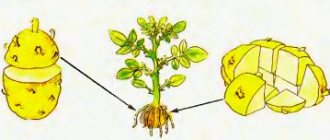When can you reproduce?
Mock orange belongs to the Hydrangeaceae family, but is popularly called “garden jasmine.” The shrub received the Latin name “Philadelphus” in honor of the king of Egypt Ptolemy Philadelphus, and the Russian name “mock orange” - due to the fact that smoking pipes and mouthpieces were made from its hollow stem.
Chubushnik - garden decoration
The height of the bush is 1-2.5 m, the stems are flexible, thin, the leaves are light green and bright. Flowers are collected in inflorescences, which are formed on short lateral shoots. They can be simple, cup-shaped, goblet-shaped, semi-double or terry, white or cream shades.
Mock orange blooms at the end of June - July for 3 weeks, when the spring colors have already faded, garden jasmine begins to delight with its beauty and fragrance.
Mock orange blossom
Mock orange is an unpretentious plant and can be propagated by all methods known in gardening. How mock orange jasmine reproduces:
- dividing the bush;
- cuttings;
- seeds;
- layering.
The timing when reproduction can be carried out depends on the selected breeding method:
- The favorable period for dividing the bush is March-April.
- When propagating by cuttings, three methods are used: spring, summer and autumn-spring. Autumn harvesting of cuttings begins after the leaves fall. Lignified gray cuttings are cut and left for winter storage in a cellar or basement at a temperature of 3-5 ℃ above zero, while the stems are deepened into a container with wet sand. You can start planting in the spring, when the flower buds swell. When cutting in spring, young green shoots are chosen before the bush begins to flower; how to propagate mock orange by cuttings in the summer - after flowering.
- Seed propagation is carried out in the fall - in November or in the spring - in April.
- Layerings are strong, well-developed shoots, dug in at the end of April - beginning of May, throughout the season, you must not forget to water them, and in the fall, the cuttings that have taken root can already be transplanted to a permanent place of residence.
How to propagate garden jasmine
When jasmine is grown for a long time, sooner or later the need for its propagation arises. This is necessary not only to plant as many bushes as possible in the garden, but also to thin out the plantings (if the bush is too large, it reproduces by division) or to renew the plant if it has been growing for a very long time.
This is how jasmine blooms
How does jasmine bush propagate:
- cuttings;
- layering;
- seeds;
- dividing the bush.
All of these methods of planting shrubs have their own characteristics. The most common methods are dividing the bush and cuttings. The most difficult thing is to plant jasmine with seeds. The seed method is used mainly by experienced flower growers or breeders.
Propagation by seeds
How to propagate garden jasmine in spring and summer
How to propagate mock orange from seeds? This is the longest and most difficult method of reproduction. Moreover, using this method, you may not get the desired result, since only species characteristics are transmitted by seeds, and varietal characteristics are lost. But if you already have a treasured box of seeds in your hands, plucked from a neighbor’s bush, it’s worth trying to grow a shrub.
Mock orange seeds
When sowing seeds in autumn, you must perform the following steps:
- Collect seeds from a ripe capsule picked in September, put them in a bag or bag and put them in a cool place. Stratification lasts from 50 to 60 days.
- Sowing of seeds is carried out on the site, in open ground. The plot of land must be prepared in advance: dig up, apply fertilizer, form ridges. In November, the seeds are mixed with sand and scattered in ridges. The seeds are sprinkled with dry compost or straw on top and covered with branches to protect them from the wind. After the snow melts, the branches are removed, and the area with the seedlings is shaded from direct sunlight.
Mock orange seeds can be purchased at the store
In spring, seeds are sown in April in a prepared container with soil. The seeds must first be prepared:
- Place the seeds in a cloth bag and dip it in a cup of water at room temperature for 2 hours.
- Place the bag of seeds in sawdust or peat for 3 days. During this time, the seeds will swell and germinate faster after planting.
- Mix the prepared seeds with sand, sow in a pre-prepared box with soil, which is covered with glass or film to create a greenhouse.
- Ventilate the resulting greenhouse daily and spray the crops 2 times a day. The first shoots should appear in a week.
- It is recommended to treat the seedlings with a weak solution of potassium permanganate to avoid the “black leg” disease. Continue ventilation of the greenhouse and spraying.
- After the appearance of the fourth leaf, the seedlings dive.
- At the beginning of summer, strengthened seedlings are transplanted into open ground, to a shaded area.
- For winter protection from frost, the sprouts should be covered with dry compost or peat.
- Next spring, to form a dense bush, the above-ground part must be cut off and transplanted to a permanent place in the fall.
Soaking the seeds
Cuttings
How to propagate gooseberries in spring, summer and autumn
Cuttings of mock orange are suitable for propagating varietal species of shrubs; this method preserves all the characteristics of the variety. This method is also convenient because cuttings can be carried out throughout the season.
Mock orange seedlings
Spring propagation by cuttings is carried out in late April - May, before flowering begins. To do this, young green branches are broken off together with the heel (a piece of bark from the main shoot), which promotes better root formation. The required length of the cutting is 5-7 cm. The lower leaves of the cutting must be torn off, leaving only one pair, so that all the strength of the branch goes towards creating the root system. You need to prepare a pot with soil mixture in advance: 1 part peat is mixed with 1 part sand. Stick the prepared cuttings into the prepared soil to a height of 2 cm. Cover the top of the pot with a cut plastic bottle to create a greenhouse climate. It is recommended to ventilate the cuttings daily, removing the plastic cap, and spray them. The first roots will appear in 2-3 weeks, and it will be possible to transplant the sprout into the garden only in mid-autumn.
Cuttings of mock orange in spring
Propagation of mock orange by cuttings in summer is also possible. If there is not enough time in the spring and the garden jasmine has already bloomed, then mock orange cuttings are carried out in the summer. Immediately after flowering, in June-July (depending on the variety), young branches are cut with pruning shears, making an oblique cut at the bottom and a straight cut at the top. Further steps for cutting mock orange in the summer are the same as for spring planting.
When cutting in autumn, after the leaves have fallen, already lignified branches, 15 cm long, are cut with pruning shears. Prepared cuttings can be stored in a plastic bag in the refrigerator or buried in sand in the cellar. You can plant cuttings in open ground when the soil has already warmed up or in a pot in early spring. The shoots go deep into the ground to the top bud.
Mock orange cuttings in a growth stimulator
Important! The optimal temperature for the formation of the root system is 20-22 °C above zero. When cold weather is expected, it is better to leave the container with the planted cuttings in the house.
For any cutting method, it is recommended to treat the cuttings with a growth stimulant before planting. How to root mock orange. You can use home remedies (aloe juice, yeast solution, willow water) or chemicals (kornevin, zircon, heteroauxin). The twig is dipped in the solution for a period of 6 to 12 hours.
Important! Do not forget about watering; the soil in which the cuttings grow should always remain moist.
Propagation by cuttings is a fairly simple method and always produces results.
Planting mock orange
In the middle zone and southern regions, mock orange can be planted both in the first half of autumn and in early spring. However, if you live in the northern region or are going to plant varieties that are not very typical for your climate, then it is better to postpone planting until spring. In this case, the plant will have enough time to take root and gain strength for wintering.
Place a 15-centimeter layer of crushed stone or expanded clay at the bottom of a 50x50 cm hole, then fill it with a mixture of leaf soil, humus and sand (3: 1: 2). Plant the seedling at the same level at which it grew previously or 2-3 cm lower. If you deepen it too much, the plant may begin to rot.
- Ornamental trees and shrubs - how to plant them correctly
Find out everything about how to plant a tree or bush in a suburban area.
Reproduction by layering
Chubushnik shneeshturm - description, planting and care
How to propagate mock orange by layering is very simple. Reproduction by layering is a very effective and uncomplicated method. To do this, at the beginning of spring, before the buds open, the following actions are carried out:
- The soil around the bush needs to be dug up, fertilized and holes made 1.5-2 cm deep.
- Place layering in the holes, pour water on top and sprinkle with soil.
- The top of the layer is not buried; it must be tied to a peg so that its growth is vertical.
Important! For reliability, secure the mock orange shoots in the hole with slingshots made of twigs or wire.
After a while, roots and sprouts form from each bud on the buried shoot. As young shoots grow, they are hilled up to a height of 10-15 cm.
Reproduction of mock orange by layering
During the summer period, water and loosen the growing bushes. In the fall, cut cuttings from the main bush, dig them up and use pruning shears to divide them between the buds into bushes. Plant the prepared seedlings on the site.
Watering and feeding mock orange
Mock orange, which grows in optimal conditions, may require feeding only in the second or third year after planting. If you notice that the leaves of the bush have drooped and lost turgor, with a high degree of probability the mock orange simply does not have enough liquid and it will easily recover some time after watering.
In the second year after planting in the spring, mock orange is fed with complex mineral fertilizer, for example, Azofoska or Nitrofoska. From the third year, in the spring or immediately after flowering, potassium-phosphorus fertilizers are applied (40-50 g of fertilizer per 10 liters of water for each bush).
Caring for mock orange does not require specific skills, which means that even a beginner can cope with growing this shrub.
Dividing the bush
How to propagate mock orange by dividing the bush? This can be done in early spring, before the buds open, or in the fall, after the leaves have fallen. When dividing a bush you need:
- First, a day before, thoroughly water the jasmine.
- Then carefully dig up the bush and free it from clods of earth.
- The next step is to divide the garden jasmine root using pruning shears. The number of new bushes can be according to the number of shoots, the main thing is that they have a sufficient number of roots left. If the root system is not sufficiently developed, divide it into parts of several shoots.
- The upper part of the shoots and the lower part of the roots of the bushes are cut off.
- In the new place, holes are prepared to the depth of the first buds on the shoots. Mix the soil with fertilizers, compost or peat, treat with manganese or fungicides. Pour a bucket of water into the hole.
- Place the bushes in the holes, cover with prepared soil, and water.
Reproduction by dividing the bush
When planting in spring, the bushes will take root and strengthen in a new place by autumn; when planting in autumn, it is necessary to prepare the seedlings for winter - cover them with dry peat or cover them with spruce branches.
Mock orange shelter for the winter
Rooting cuttings
Let's consider the next stage, which allows us to understand how to propagate homemade jasmine. It involves rooting cuttings. This procedure can be performed in two ways:
- Using liquid. You will need boiled and settled water. The stalk is lowered into it. After 2-3 weeks, roots will appear on the shoot. You need to wait until they grow to 2 centimeters. After this, the cutting can be replanted. Initially, a mixture consisting of peat and sand is prepared for it. Just remember to moisten the soil before planting.
- Using sand and peat. You can immediately plant the cuttings in such soil. It is believed that this mixture is very suitable for jasmine. Because he doesn't like excessive moisture. In this soil, the cutting quickly takes root.
Care after breeding
Young mock orange seedlings will require attention at first:
- When choosing a planting site, you need to take into account in advance that the plant does not like prolonged exposure to direct sunlight. If it was not possible to find a shaded place, then the young bushes will have to be shaded.
- Mock orange needs to be fertilized. When planting, fertilizers were already applied to the hole, which should be enough for two years, but still, in small quantities 2 times a year, it would not hurt to treat the plant with organic and mineral fertilizers. In the spring, the plant needs nitrogen (a diluted mixture of mullein and chicken droppings is suitable) and potassium and superphosphate in the summer to strengthen the root system after the winter cold and to grow green mass.
- The bushes need to be watered regularly; it is better to do this in the morning or evening with warm, settled water.
- After watering, the soil in the tree trunk circle is loosened to provide oxygen access to the roots. To retain moisture, you can cover the ground with mulch.
- The beds with young mock orange must be regularly cleared of weeds.
- In spring or autumn, molding pruning of the bush is carried out to obtain a lush mass and the desired shape.
- When preparing for winter cold, young mock orange needs to be covered. A film cap, spruce branches, dry leaves or peat are suitable for this. An adult plant does not need protection from frost.
- In the spring, after removing winter protection from the bushes, they must be treated with fungicides and insecticides to protect them from pests and diseases.
Mock orange is a gentle and unpretentious garden decoration. To propagate it, you can use any of the gardening methods. Propagating garden jasmine does not take much time and does not require much effort. The bushes have a high ability to take root and reproduce. The result will delight you in 4-5 years with beautiful flowering mixborders or hedges with an exquisite aroma.
Where to plant mock orange
Mock orange loves open sunny spaces, but also feels very good in partial shade. Purely theoretically, you can plant it even in a dark corner of the garden, and the bush will not only not die, but will also delight you with its flowering. However, it will no longer be the shrub strewn with white flowers that you are used to seeing, but its pale copy. However, if you are not chasing lush flowering and a small number of flowers is enough for you, then mock orange can be an excellent option for landscaping a shaded area.
Mock orange is unpretentious to soils, but the most optimal for it will be fertile and well-drained soil of neutral acidity.











